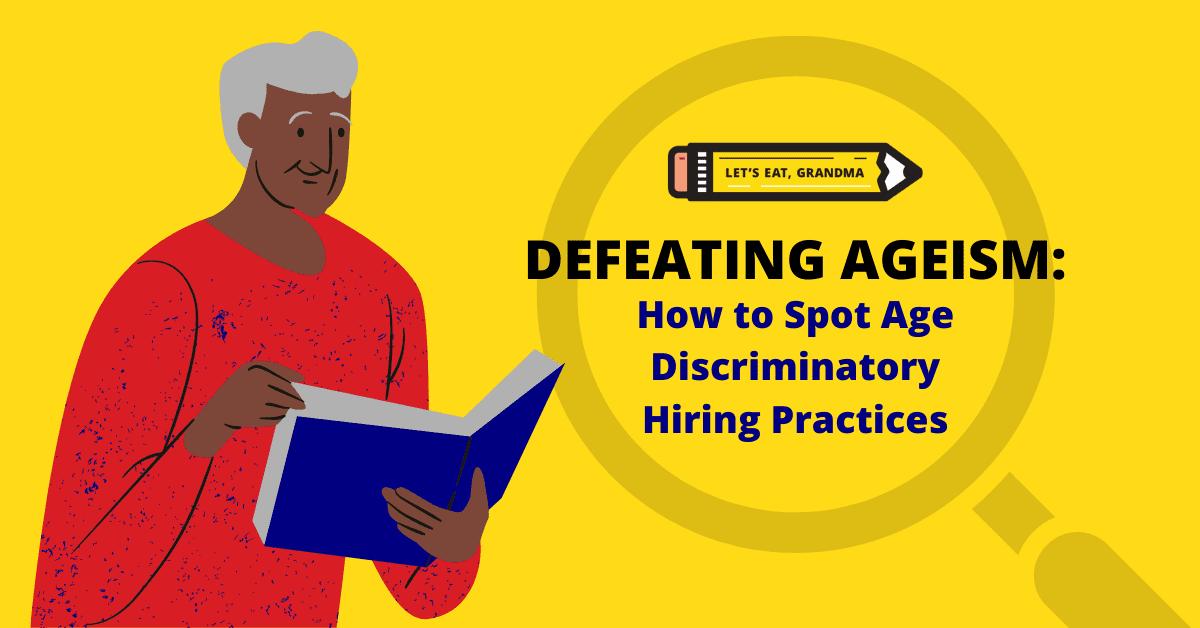Defeating Ageism, Part 3: Older Job Seekers, Look for These Red Flags From Companies

We’ve discussed how you can proactively prepare your resume and cover letter to combat ageism, but what if you encounter something suspect in a company’s hiring practices or company culture? Read on for how to proceed when something feels a little … off.
By: Grace Mitchell | Contributor for Let’s Eat, Grandma
This is Part 3 of our Defeating Ageism series. You can find Part 1 here and Part 2 here.
We’ve talked a bit now about what you can control to avoid age discrimination, but what about on the company end? The hiring process isn’t just about you proving that you’d be a good choice for your company; the company also needs to prove that they’d be a good choice for you.
If your company shows signs of age discrimination during the hiring process, chances are that same discrimination will follow you at the office. We want you to thrive in your new job, but that’s hard to do if you’re continually having to prove to your coworkers that you’re capable despite their prejudiced expectations of you.
So what are some warning signs that a company could be a hostile work environment for older employees?
Ready for more job search help?
Sign up for a free Senior Writer Resume Critique to see what's holding you back from landing interviews. One of our top professional resume writers will give you personalized feedback on the top 3 items you can improve based on our expert practices!
In the Job Description

Reading the job description carefully will help you spot red flags. Photo by Tetiana SHYSHKINA on Unsplash
We mentioned in part 1 that job descriptions often use coded language to imply they want younger candidates, but we’ll break this down further here. If a job description uses coded language, it’s a strong indication that you’ll be stuck continually having to prove yourself to coworkers, even if you convince your hiring manager that you’d be a good fit. Watch out for job descriptions that use these terms:
“Recent college graduate”
The EEOC (Equal Employment Opportunity Commission) warns employers against using this descriptor, yet it’s still used to describe an “ideal candidate” in thousands of online job postings.
“Digital native”
A digital native is someone who grew up around technology, as opposed to a “digital immigrant,” who learned computer skills later in life. Of course, whether you grew up sharing pictures of your cat online or not doesn’t define how well you use job-specific technologies.
“Energetic,” “fast-paced,” and similar terms
While these terms don’t have the same implicit bias as those above, many employers, stereotyping older workers as slow, use them to discourage older job seekers from applying. On the other hand, some employers just aren’t aware of the weight these words carry and may use them without intending harm. If one of these speed-related terms is the only warning sign the company displays, you may be in the clear.
In the Interview
Ageism in interview questions may take obvious forms, but it can also be more subtle. Here are some ageist interview questions and ways to respond:
How old are you?
Asking this question is actually illegal under the Age Discrimination in Employment Act. While pointing that out probably won’t help you get hired, it’s unlikely that a company that would blatantly violate this act would be a welcoming place to work. Even so, if you still want to pursue the job, you can flip the script so that your experience is highlighted rather than your age. “Old enough to have x years of experience and to have accomplished x, y, and z in my career” will speak better to your experience than telling the hiring manager your actual age.
Will this position be engaging enough for you?
Older job seekers looking to transition to a bridge job – a lower-intensity full- or part-time position – before retiring may be hit with a question like this. If that’s the case for you, be clear on why you think you’d be a great fit for the job. Does it allow you to engage with a passion? Are you seeking to diversify your skills? Note that while “more time for family/hobbies/leisure” may be a big motivator for you, it’s likely not the answer the hiring manager is looking for.
Our company uses state-of-the-art technology. Can you adapt to a changing environment?
Making assumptions on your flexibility and technology skills is a sketchy move, but questions like this also give you the opportunity to highlight some transferable skills. Use specific examples from your career of times you’ve learned new programs or adapted through a major shift in a past company’s structure.
In the Company Culture

Take a look around when you interview: A good sign of inclusive hiring practices is a diverse staff. Photo by Christina @ wocintechchat.com on Unsplash
One final way to check for red flags is to research the company you’re applying for. While we always recommend this practice, it’s especially important when evaluating a company for signs of ageism. What are the company’s values? How do they engage with equity, diversity, and inclusion work? Are they transparent about their employee demographics? Finding answers to these questions can help you determine if the company is right for you.
Network within the organization
Another great way to gauge a company’s attitude toward older workers is to build connections within the company. Not only will networking help you get your foot in the door, it can also help you determine if it’s a door you’d even want to walk through once you have that in! If your new connections tell you that they have just one coworker over 40 who’s on the receiving end of several jokes, it’s unlikely you’ll be treated more fairly.
Use your interview for further research
Again, the interview isn’t just about convincing someone to hire you: it’s a two-way street. Use this time of intentional dialogue to ask about the company culture. What does the interviewer love about working there? What could they stand to improve? If it wasn’t clear in your research, consider asking about their efforts toward equity, diversity, and inclusion. Does your interviewer evade or fumble through these questions? If so, consider moving on.
Don’t Forget to Check for “Green Flags”
While there are many telltale signs of ageist company cultures, other companies demonstrate evidence of inclusive environments for older workers. While you’re searching for red flags, look for these “green flags” as well: transparency about the company’s inclusion efforts and/or age diversity, older employees in areas of leadership, phased retirement programs and incentives, and partnerships with organizations like AARP.
Finding a new job with a company that honors your age and experience (in a way that isn’t creepy or tokenizing) can be a challenge, but don’t lose hope! Age-diverse companies are out there, and, by knowing what to avoid, you’re one step closer to finding them.
Ready for more job search help?
Sign up for a free Senior Writer Resume Critique to see what's holding you back from landing interviews. One of our top professional resume writers will give you personalized feedback on the top 3 items you can improve based on our expert practices!
Better Resume.
Satisfying Career.
Happier You.
